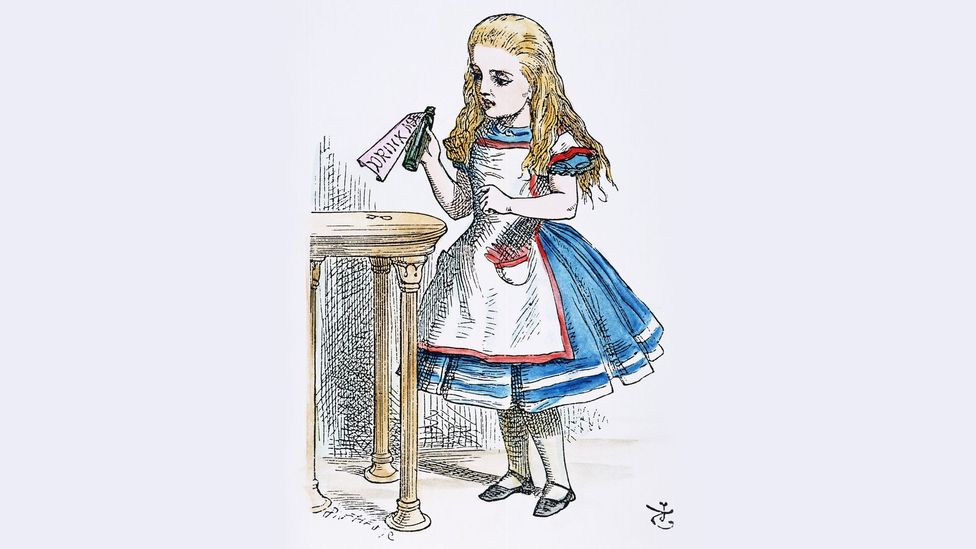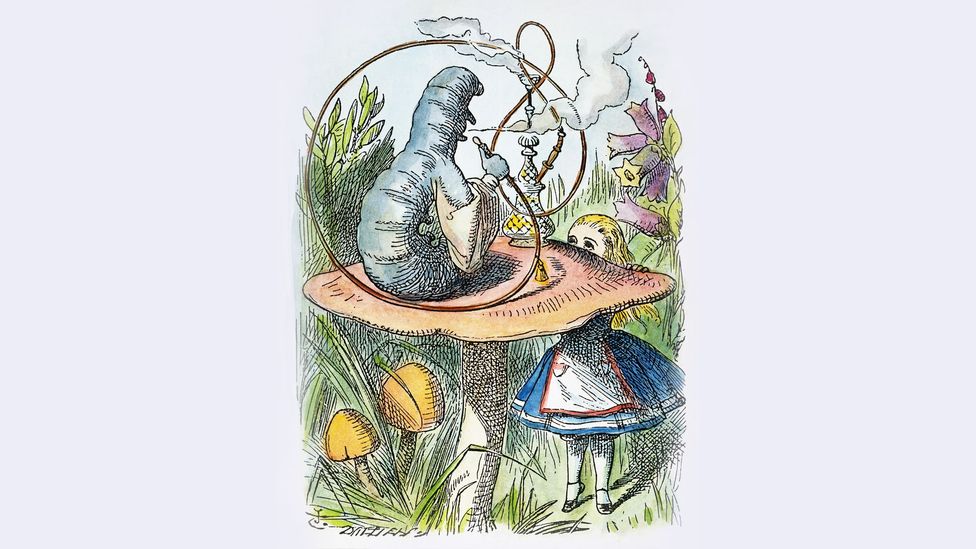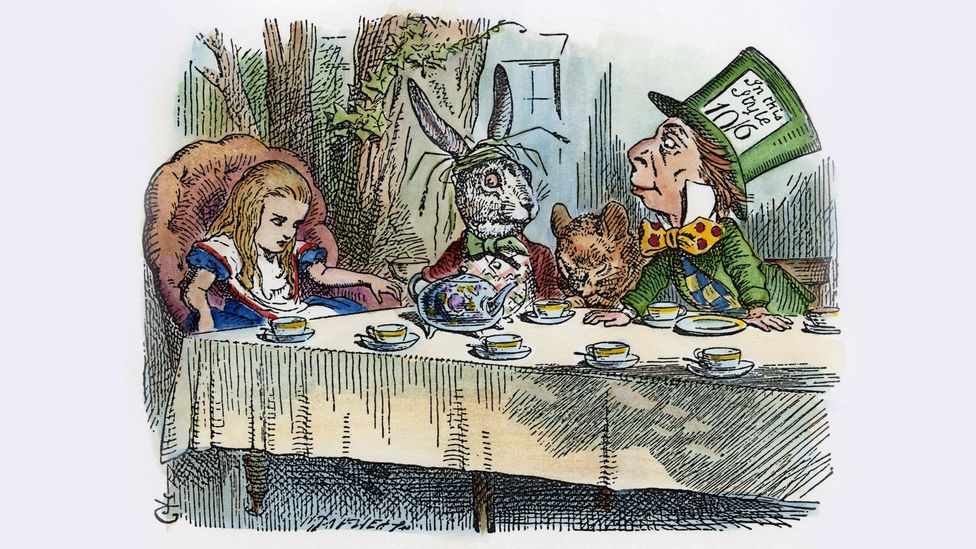Is Lewis Carroll’s tale really about sex, drugs, and colonialism? Some say yes. Others argue it’s about eating disorders or the Wars of the Roses. Hephzibah Anderson takes a look.
This is an updated version of an article originally published in 2016.
To fully experience what it means to tumble down a rabbit hole, just ask the internet about hidden messages in the book that so vividly gives us the image, Alice's Adventures in Wonderland. Lewis Carroll's fantastical tale of magic cakes and secret doors, grinning cats and warbling turtles, has never been out of print since it was first published – and has just come second in BBC Culture's Greatest Children's Books poll. Over the course of a century and a half, it's inspired films, paintings, a ballet and computer games. There's even a neurological syndrome named after it. Yet its most capacious by-product by far is alternate readings. Delve into the writings of generations of critics, scholars and bloggers, and this beloved juvenile classic becomes variously an allegory on drug culture, a parable of British colonisation, and the story of a heroine with a bad case of penis envy.
Read more about BBC Culture's 100 greatest children's books:
The 100 greatest children's books
Why Where the Wild Things Are is the greatest children's book
The 20 greatest children's books
The 21st Century's greatest children's books
Who voted?
#100GreatestChildrensBooks
The book began life modestly in 1862, as entertainment for 10-year-old Alice Liddell and her two sisters as they boated on the River Thames with mathematician Charles Dodgson and his clergyman friend. It proved such a hit that Alice insisted Dodgson transcribe it, which he duly did. Meticulously handwritten in sepia ink, it contains not a single mistake and is filled with his own detailed illustrations. Inscribed "A Christmas Gift to a Dear Child in Memory of a Summer's Day", it carries the nom de plume under which he'd previously published some poetry, Lewis Carroll.
Alice was the daughter of the dean of Christ Church, the Oxford college where Dodgson taught. He was an avid practitioner of the newfangled art of photography, and their friendship evolved through his efforts to capture her and her sister on film. His lens was especially drawn to Alice, and she stares assertively out of the portraits he obsessively took of her, meeting the gaze with striking self-possession.
The Liddell girls weren't the only children Dodgson befriended, and while there is no proof of anything explicitly untoward in his relationships with them, from our 21st-Century vantage point, it's hard not to view as queasily suspect a grown man who not only sent his young playmates wonderful letters full of puns and puzzles, but also requested locks of their hair and asked them to sit on his lap and pose for photographs, occasionally nude or semi-nude.
Victorians, of course, looked on the situation differently. For a start, the pictures he created weren't unusual – another pioneer of photographic portraiture, Julia Margaret Cameron, shot plenty of images of children both in costume and in various states of undress. Moreover, what caused eyebrows to be raised among Dodgson's contemporaries wasn't the idea that he was spending time with very young children but that he might be fraternising with girls nearing what was then the legal age of consent: 12 (it would rise to 16 in 1885).
Biographers have long wrestled with the question of the true nature of Dodgson's attachment to little girls. When it comes to Alice, the mystery is deepened by a rift that occurred sometime in 1863, around a year after that fabled boat trip. Did he wish to marry Alice? Could he have been intent on wooing her older sister Lorina or even Miss Prickett, their governess? All have been suggested and pages cut from Dodgson's diary amplify the uncertainty.
With the waning of Victorian prudery and the birth of psychoanalytical theory, Alice's Adventures in Wonderland seemed a good deal less innocent
It's not only Dodgson himself who has come under fresh scrutiny as society has evolved. With the waning of Victorian prudery and the birth of psychoanalytical theory, his book came to seem a good deal less innocent. Re-examining the text, critics found plenty of gynaecological imagery, from the rabbit hole itself to the curtain that she must push aside. Locks and keys were seen as symbolic of coitus, and the caterpillar – well, wasn't he just a bit… phallic? Inevitably, some saw penis envy in the text, rendering Alice's extending neck a kind of copycat erection. And then there's the fanning that she does before she starts to shrink, and the salt water that laps her chin once she's mere inches tall – both acquire a decidedly masturbatory glossing.
More nuanced readings have viewed Alice's journey as being less about sex per se and more about a girl's progress through childhood and puberty into adulthood. Our heroine feels uncomfortable in her body, which undergoes a series of extreme changes; her sense of self becomes destabilised, leaving her uncertain of her own identity; she butts heads with authority and strives to understand seemingly arbitrary rules, the games that people around her play, and even death.
Famed literary scholar William Empson got especially carried away, declaring that Alice is "a father in getting down the hole, a foetus at the bottom, and can only be born by becoming a mother and producing her own amniotic fluid".
Of course, sometimes a caterpillar smoking a hookah is just that – especially when he's flanked by a magical mushroom. Since the 1960s, drug-lovers have read Alice's antics as one big trip. The lyrics to Jefferson Airplane's White Rabbit did a fair bit to cement the association: "Remember what the Dormouse said / Feed your head, feed your head." From its heat-addled opening scene, there is a psychedelic vibe – besides all those pills, time moves erratically, and the grinning Cheshire Cat is here one minute, gone the next.
One of Dodgson's own favourite authors was Thomas De Quincey of Confessions of an English Opium Eater fame, but though he dabbled in homeopathic cold remedies, there is no concrete evidence that he ever experimented with mind-altering drugs. Still, the druggy associations endure, as a line from The Matrix shows: "You take the blue pill, the story ends, you wake up in your bed and believe whatever you want to believe. You take the red pill, you stay in Wonderland, and I show you how deep the rabbit hole goes."
But it's not all sex and drugs. Another strand of criticism views Alice as a political allegory. When our heroine leaps after the White Rabbit, she ends up in a place that, for all its zany, disconcerting strangeness, is ruled over by a quick-tempered queen – Dodgson reputedly had mixed feelings about Queen Victoria even though she loved his book – and has a shambolic legal system, much like Victorian Britain.
And how does Alice act in this strange land? Befuddled by the natives' way of doing things, she tries to impose her own values with very nearly calamitous results. Couldn't the novel therefore be an allegory for colonisation?
There's also the question of The Walrus and the Carpenter, the poem that Tweedledum and Tweedledee recite to Alice. According to some interpretations, the carpenter is Jesus and the walrus Peter, with the oysters as disciples. Others insist that it's about Empire, with the walrus and the carpenter representing England, and the oysters its colonies. Even JB Priestley weighed into the debate, suggesting that the walrus and the carpenter are instead archetypes of two different types of politician.
To peruse the wild and wacky theories that successive generations have dreamt up concerning the "true" meaning of Alice's adventures is to understand how changing social mores can radically alter a text. Of course, it's a testament to the work's essential timelessness that each era has been able to read its own fads and preoccupations into the story.
It's perhaps a testament to something else, too: the unsolvable mystery of its author's deepest self, and the space that creates within the text for a kaleidoscopic multitude of interpretations. His friendships with children cast an undeniable shadow, and in the V&A's blockbuster 2021 exhibition, Alice: Curiouser and Curiouser, he was notably backgrounded, the famous and, it's argued, provocative portrait he took of Alice Liddell as "The Beggar Maid" nowhere to be seen. But while the likes of the #MeToo movement has added urgency to the vexed question of whether it's possible to admire good art made by bad people, in the case of Charles Dodgson, we're unlikely to ever truly know whether he was a repressed predator or a kindly don, shy and stuttering. Indeed, as writer Katie Roiphe has suggested, it's possible that none of the categories available to us today can contain him.
His muse, by contrast, grew up to lead the kind of life expected of a woman of her class, and after briefly catching the attention of Ruskin and the Prince of Wales' son, Leopold, she settled down as Mrs Reginald Hargreaves. Of her three sons, only one survived World War One, the child she'd named – purely coincidentally, she always maintained – Caryl.
Meanwhile, debate about the world of her fictional alter ego rages on like a never-ending mad hatter's tea party. Alice is a parable of eating disorders; a cautionary tale about the then new-fangled symbolic algebra; a satire of the Wars of the Roses. In the wacky realm of rival theories, we all become as confounded as Alice.
In his day job, Dodgson lectured on mathematics, and it's little wonder that his stories are teeming with arithmetical and geometrical allusions. Alice is confronted with a series of puzzles from the Mad Hatter's riddle to the Queen's croquet game, but try as she might to solve them, they invariably turn out to have little purpose and no answer. Though Dodgson was a logician, Wonderland is a realm in which illogic rules. And maybe that's where the ultimate message of his exuberantly inventive book lies: the world is a mad place in which expectations are often frustrated. Rather than striving to lock down meaning, we'd do better to simply delight in the ride.






